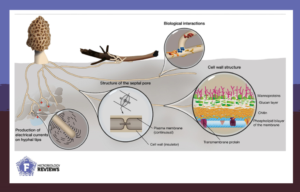What do mushrooms on your plate and the tangled cables behind your computer have in common? Both use electric currents running along “wires” to transfer signals. While we are familiar with electrical wires, scientists are now uncovering how fungi transmit electrical signals within their extensive hyphal networks. The article “Electrical signalling in fungi: past and present challenges” in FEMS Microbiology Reviews presents how this signalling mechanism works and the caveats to study it. Matteo Buffi and Pilar Junier discuss the importance of this topic. #FascinatingMicrobes
Why electrical signalling in fungi matters
Cells use electrical signalling as a universal mechanism for sending messages. Animals have nervous systems and plants have their own slow but clever electrical networks. What about fungi though? They are only just starting to reveal their secrets.
Fungal hyphae are thread-like multicellular structures, that grow and branch out to explore their surroundings. The tip of the hyphae interacts with other organisms or forages the environment for resources.
Some researchers believe that fungi might use electrical signals to coordinate their growth or even communicate with plants through underground networks called mycorrhizal systems. According to the ‘Wood Wide Web’ hypothesis, fungi help trees share their resources or alert them about herbivory attacks.

Research on this topic was active around 1970’s but became unattainable until recently. This is why piecing together different studies on the topic was important. The review, as “Electrical signalling in fungi: past and present challenges” in FEMS Microbiology Reviews explores methodological caveats to measure and interpret electrical signalling in fungi.
Fungi sending messages using electrical signals
This review attempted something unconventional; in addition to presenting the evidence collected by other researchers, it also outlined caveats that were identified when replicating previous studies or testing novel experimental methods.
Measuring electrical signals in filamentous fungi is very tricky. Fungi are small, and the strength of these electrical signals is even smaller.
Researchers tried to pick up those signals by piercing hyphae with glass needles, using vibrating electrodes, or high-tech multi-electrode arrays. It became clear that the currents occur only in specific areas of the mycelium and in response to food sources. However, it is still unclear whether these signals constitute a true means of communication or even a “language”.
Moreover, studies based on inhibitors and mutants identified the involvement of membrane channels in ion transport. Their nature, however, is quite different from those found in animals.
The review further highlighted that all methods come with their own caveats – signals can be drowned out by background noise or disrupted by the very tools meant to detect them. The use of newer techniques, like dyes that light up when they detect electrical changes, are promising but require better ways to visualize the 3-dimensional structure of the mycelium.
The idea of discussing some of the experimental challenges of investigating electrical signalling in fungi is straightforward: Researchers new to the field can learn from the experience of their colleagues and adapt their experimental setups accordingly to get to conclusive results quicker.
The future of electrical signalling in fungi
Understanding how fungi communicate could change how we see the natural world. But there is still a lot of work to do before we fully understand what these electrical signals are all about. One main question remains: Do fungi use these signals to convey information? To sole this, we need to figure out how they work and how to measure them reliably.
This knowledge might further help us create fungal-based electronics, improve crop health or develop eco-friendly fungi-based sensors. So, next time you see mould or mushrooms, remember they might be silently communicating via electrical messages that we are only just beginning to grasp!
- Read the article “Electrical signalling in fungi: past and present challenges” by Buffi et al. in FEMS Microbiology Reviews (2025).

Matteo Buffi is a biologist and ecologist with a specialization in microbiology, mycology and electrophysiology. His main interest lies in understanding how organisms communicate and interact within ecosystems. Passionate about both biology and technology, his goal is to develop and adapt sustainable biotechnologies across various fields to promote ecological innovation.
Pilar Junier is a microbial ecologist with expertise in the fundamental mechanisms governing bacteria-fungi interactions and how fungi coordinate their responses to environmental stimuli. Her research aims to uncover the functional and ecological processes that underlie these interactions, providing a foundation for innovative applications. She addresses pressing challenges, such as combating antimicrobial resistance and advancing sustainable technologies for metal biorecovery and bioremediation. Pilar also actively engages in public outreach and citizen science, most recently leading initiatives to monitor and raise awareness about toxic benthic cyanobacterial blooms. Through interdisciplinary collaborations and science communication, she strives to bridge microbiological research with societal needs.
About this blog section
The section #FascinatingMicrobes for the #FEMSmicroBlog explains the science behind a paper and highlights the significance and broader context of a recent finding. One of the main goals is to share the fascinating spectrum of microbes across all fields of microbiology.
| Do you want to be a guest contributor? |
| The #FEMSmicroBlog welcomes external bloggers, writers and SciComm enthusiasts. Get in touch if you want to share your idea for a blog entry with us! |
